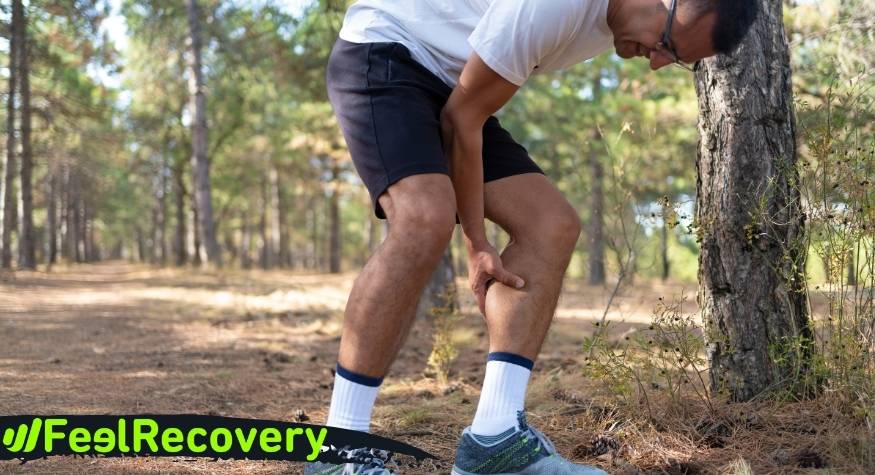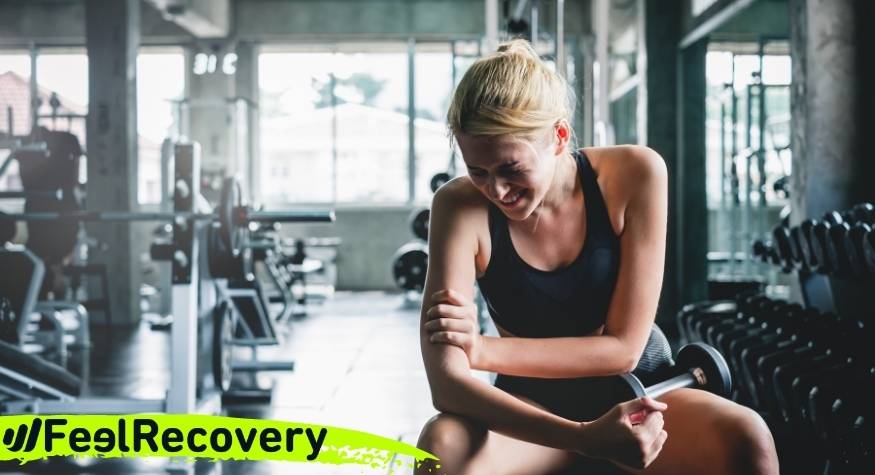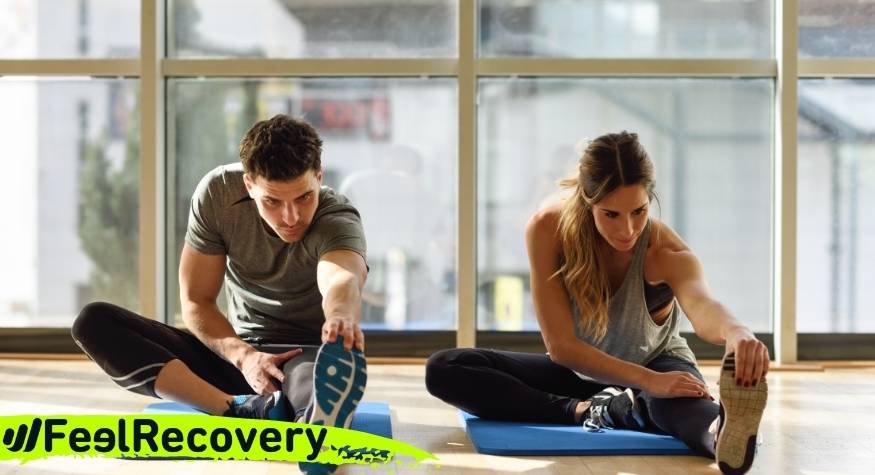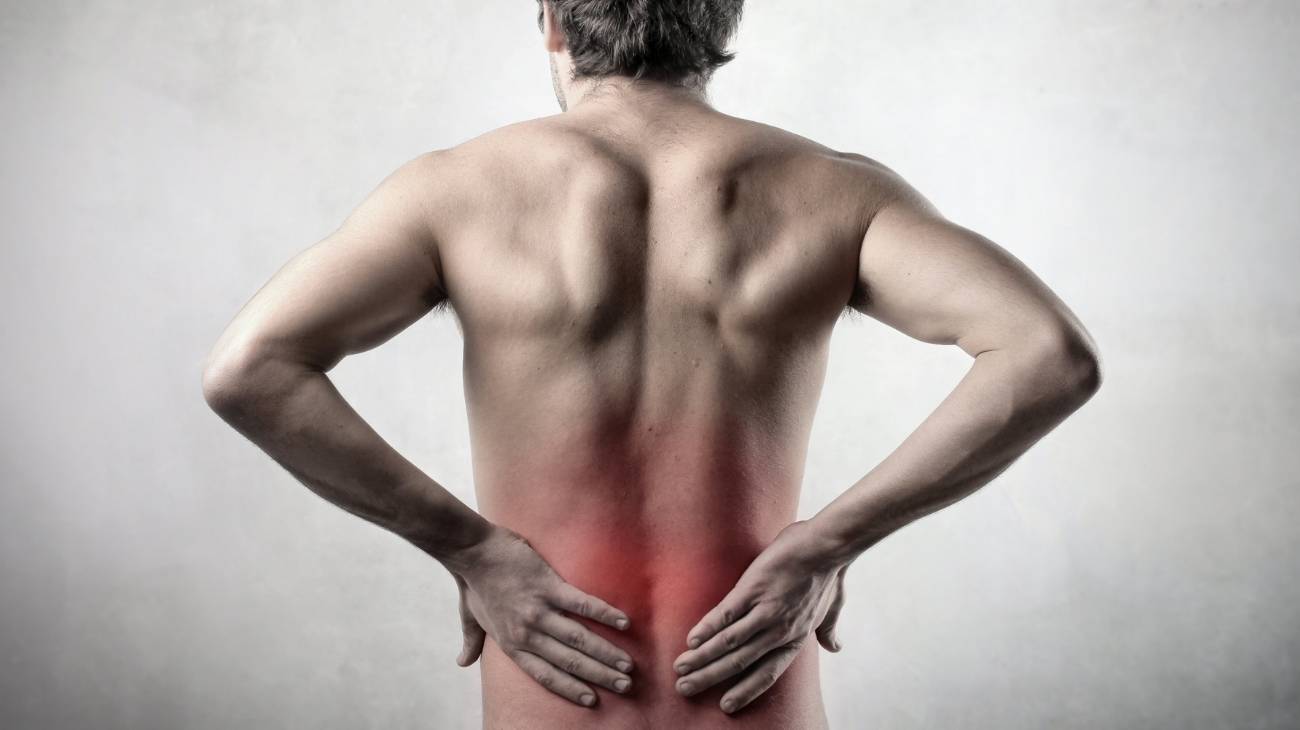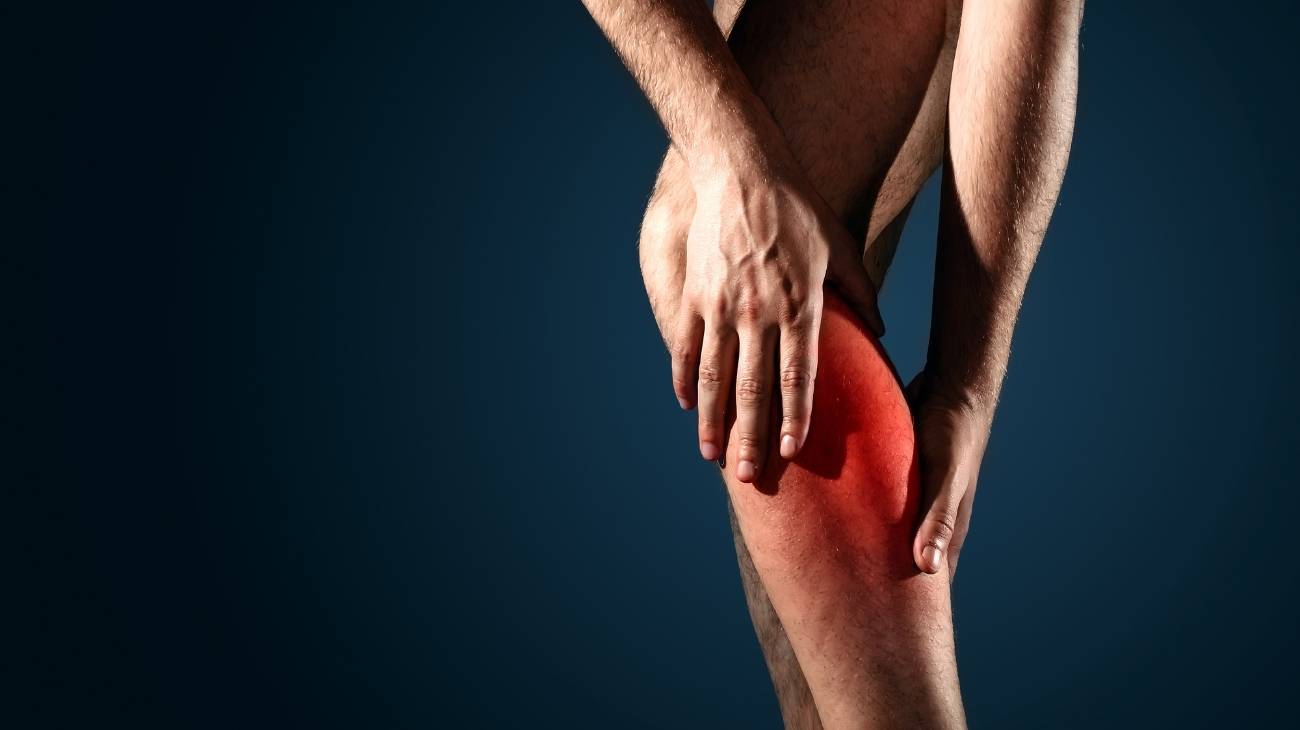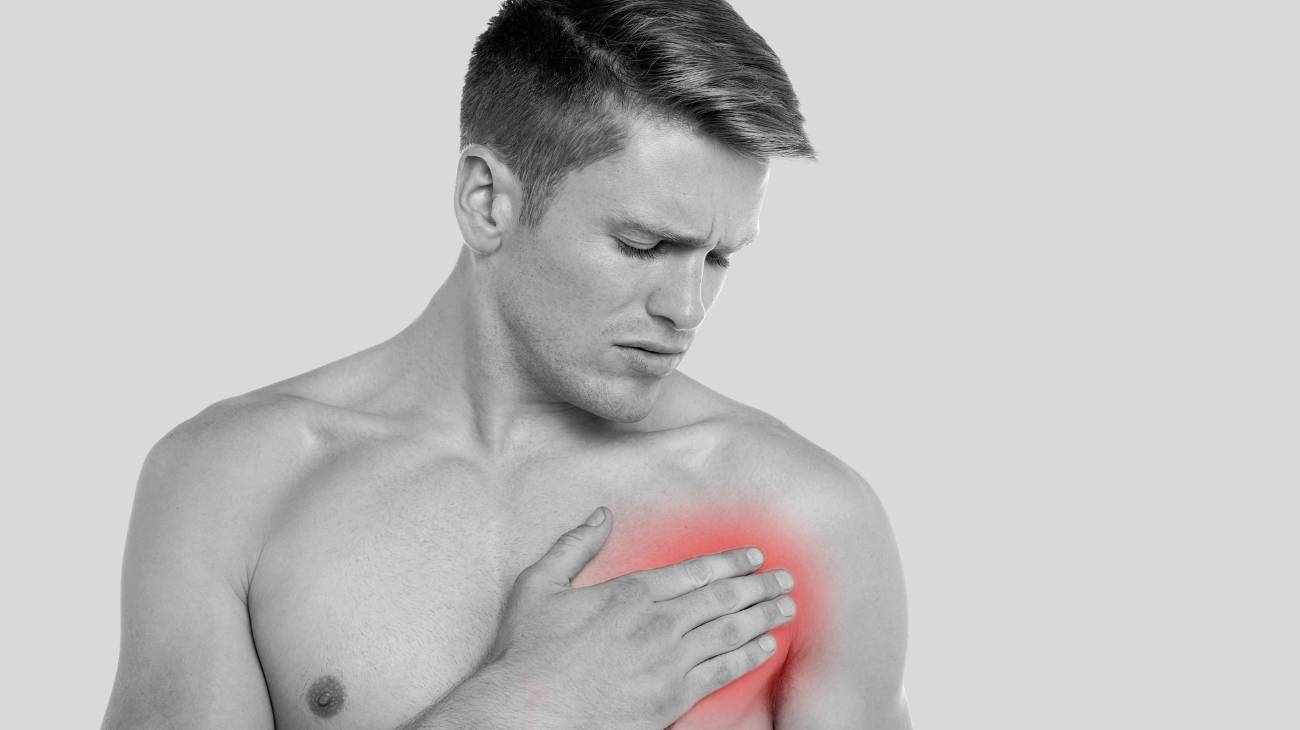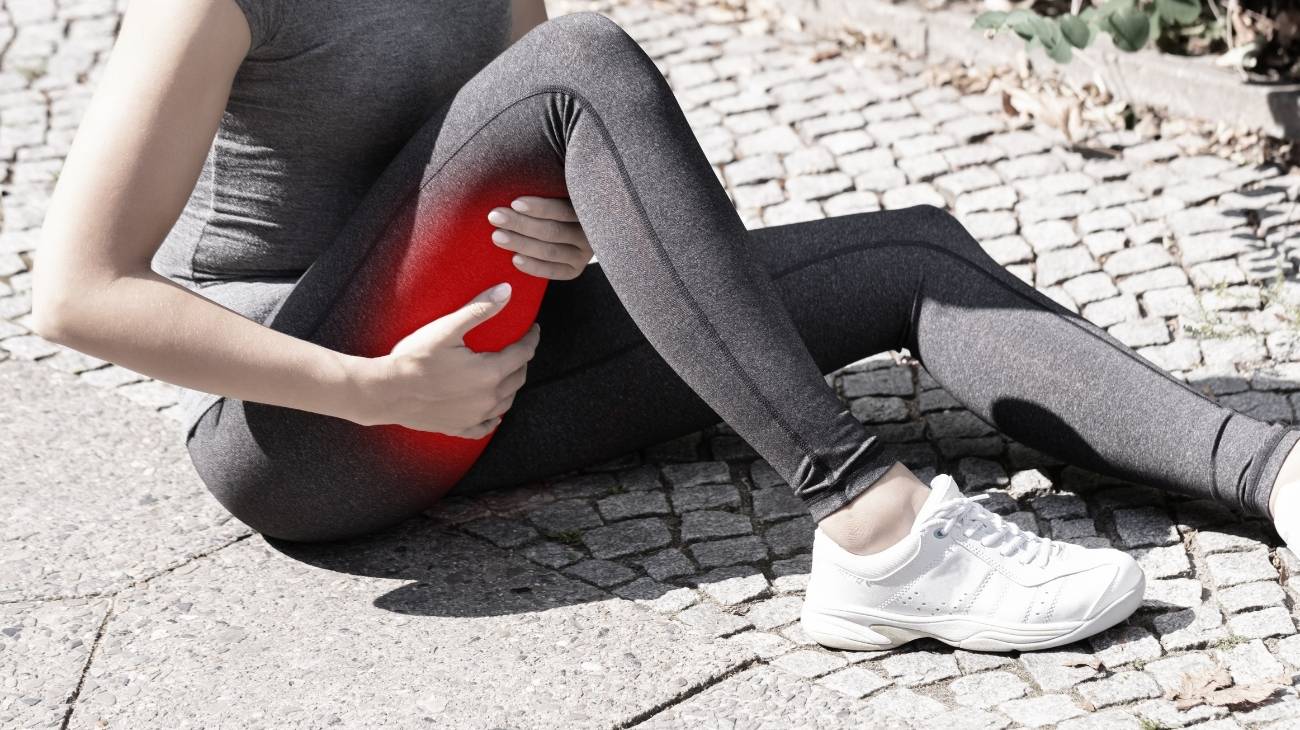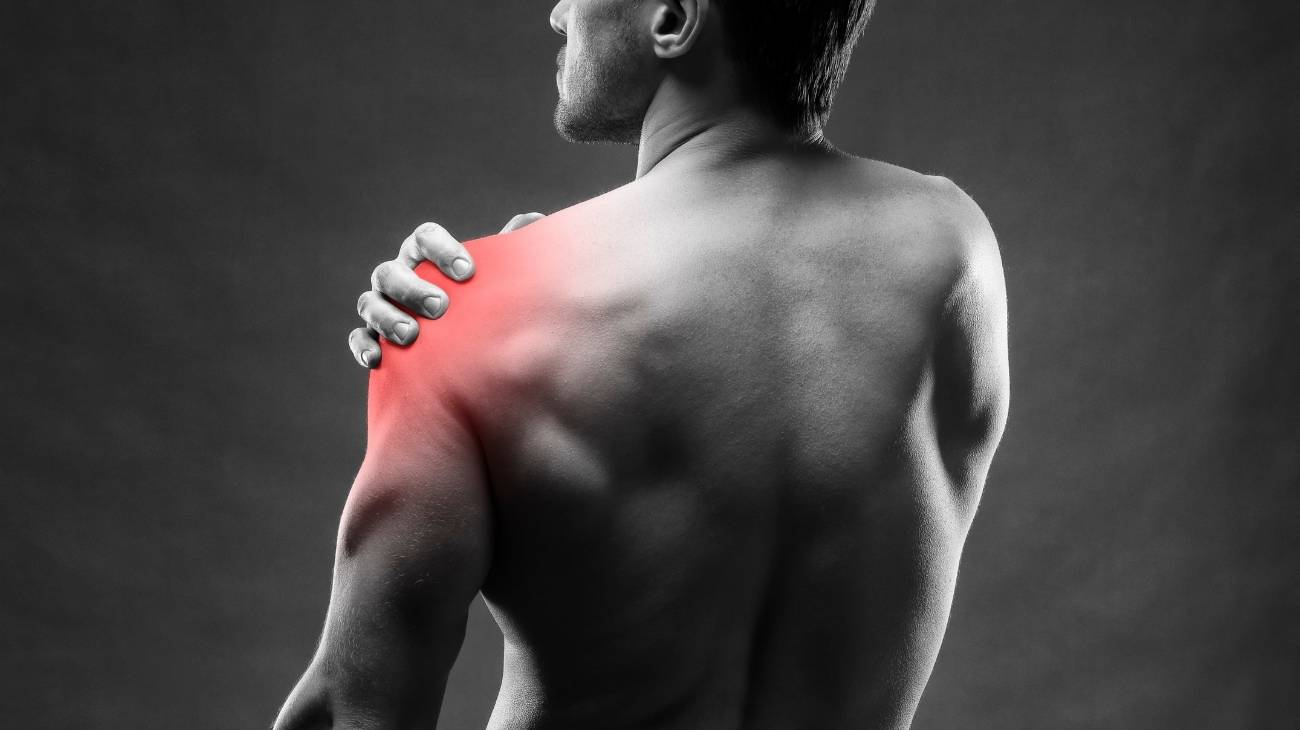- Definition: What are muscle strains?
- What are the most common types of muscle strains we can suffer from in our body?
- Best strains products
- What are the causes of muscle strain?
- What are the most common areas where a muscle pull appears?
- What treatments and prevention methods are available to improve the symptoms of strains?
- How to eliminate or relieve pain due to muscle strain?
- F.A.Q: Frequently asked questions
Stress, overexertion and a sedentary lifestyle can lead to muscle strains that cause pain, inflammation and even stiffness. This is why you need to know what muscle pulls are and what the most common types are. You will find this information in the following paragraphs.
But this is not all you can read, we will also talk about the causes of muscle strains and the most common areas in which a strain can appear. Don't miss anything because you will be able to read the frequently asked questions about this ailment.
Definition: What are muscle strains?
A muscle strains is the involuntary tension suffered by the soft tissue, causing pain, inflammation and stiffness in movements. These strains are caused by the great effort made by the muscular structure to perform a given action. The injury can occur during or after the effort, although it is also possible to find patients who suffer from muscle strains due to residual effects left in the organism.
The main reason for this type of strain is based on the inability of the bloodstream to eliminate inactive substances when movements occur, i.e. metabolites. These molecules, whether they belong to any of the metabolic pathways, remain in the body causing constant tension in the muscle. Depending on their location, symptoms such as muscle weakness, headache, dizziness, numbness of the limbs, tiredness and even drowsinessare possible.
What are the most common types of muscle strains we can suffer from in our body?
In order to remove muscle strains, it is essential to know, first of all, what type they are. The most common classification is given by their origin or cause, which is the most important point to consider. Thus, we have:
Post-traumatic or defensive strains
They occur after suffering an impact. The brain acts with a direct response based on the protection of the most sensitive structures using the muscle as a shield. They are intense, but disappear without medical help in two or three days at most.
Postural strains
They are caused by inadequate body posture, which requires a certain amount of time maintaining poor postural hygiene. The pain is generally mild or mild-moderate unless other muscles are associated, due to their proximity and union with the affected area.
Strains due to hypotonia
The weakness of the muscle causes it to spasm when we ask it to contract beyond its capacity. It does not need to be too strong; the problem is caused by the muscle condition.
Strains due to dehydration
The accumulation of toxins, generally due to a large formation and minimal or no excretion, causes episodes of muscle stiffness, with moderate pain in response to movement and a lot of tension in the soft tissues being common.
Occlusal-postural syndrome
Interestingly, muscle strain is also a symptom of this clinical picture. This is caused by a change in the position of our teeth and the temporomandibular joint and the muscle tone of the chewing muscles. This is due to a misalignment of the teeth that influences the rest.
Best strains products
Bestseller
-
2 Calf Compression Sleeve (Black/Gray)
$19.95 -
2 Calf Compression Sleeve (Green/Navy)
$19.95 -
2 Calf Compression Sleeve (Pink/Bordeaux)
$19.95 -
2 Thigh Compression Sleeve (Black/Gray)
$19.95 -
2 Thigh Compression Sleeve (Green/Navy)
$19.95 -
2 Thigh Compression Sleeve (Pink/Bordeaux)
$19.95 -
Acupressure Mat and Pillow (Black/Gray)
$49.95 -
Acupressure Mat and Pillow (Green/Navy)
$49.95 -
Acupressure Mat and Pillow (Pink/Bordeaux)
$49.95 -
Acupressure Pillow (Black/Gray)
$29.46 -
Acupressure Pillow (Green/Navy)
$29.46 -
Acupressure Pillow (Pink/Bordeaux)
$29.46 -
Back Support Belt (Black)
$34.95 -
Back Support Belt (Green)
$34.95 -
Back Support Belt (Pink)
$34.95 -
Foot Massage Roller for Plantar Fasciitis (Black)
$19.95 -
Foot Massage Roller for Plantar Fasciitis (Green)
$19.95 -
Foot Massage Roller for Plantar Fasciitis (Pink)
$19.95 -
Heating Pad for Microwave Classic Bottle Shaped (Hearts)
$19.95 -
Heating Pad for Microwave Classic Bottle Shaped (Oxford)
$19.95 -
Heating Pad for Microwave Classic Bottle Shaped (Sport)
$19.95 -
High Density Foam Roller for Muscle (Black/Gray)
$29.95 -
High Density Foam Roller for Muscle (Green/Navy)
$29.95 -
High Density Foam Roller for Muscle (Pink/Bordeaux)
$29.95 -
Ice Massage Roller Ball (Black)
$39.95 -
Ice Massage Roller Ball (Green)
$39.95 -
Ice Massage Roller Ball (Pink)
$39.95 -
Microwave Heating Pad for Back Pain Relief (Extra Large) (Hearts)
$29.95 -
Microwave Heating Pad for Back Pain Relief (Extra Large) (Oxford)
$29.95 -
Microwave Heating Pad for Back Pain Relief (Extra Large) (Sport)
$29.95 -
Microwave Heating Pad for Neck & Shoulder Pain Relief (Hearts)
$24.95 -
Microwave Heating Pad for Neck & Shoulder Pain Relief (Oxford)
$24.95 -
Microwave Heating Pad for Neck & Shoulder Pain Relief (Sport)
$24.95 -
Microwave Heating Pad for Neck Pain Relief (Hearts)
$19.95 -
Microwave Heating Pad for Neck Pain Relief (Oxford)
$19.95 -
Microwave Heating Pad for Neck Pain Relief (Sport)
$19.95 -
Microwaveable Heating Pad for Pain Relief (Hearts)
$19.95 -
Microwaveable Heating Pad for Pain Relief (Oxford)
$19.95 -
Microwaveable Heating Pad for Pain Relief (Sport)
$19.95 -
Pack 2 In 1 Foam Roller High + Soft Density (Black/Gray)
$29.95 -
Pack 2 In 1 Foam Roller High + Soft Density (Green/Navy)
$29.95 -
Pack 2 In 1 Foam Roller High + Soft Density (Pink/Bordeaux)
$29.95 -
Shoulder Support Brace (Black)
$24.95 -
Shoulder Support Brace (Green)
$24.95 -
Shoulder Support Brace (Pink)
$24.95 -
Soft Density Foam Roller for Recovery (Black)
$29.95 -
Soft Density Foam Roller for Recovery (Green)
$29.95 -
Soft Density Foam Roller for Recovery (Pink)
$29.95 -
Sport Compression Socks (1 Pair) (Black/Gray)
$19.95 -
Sport Compression Socks (1 Pair) (Green/Navy)
$19.95 -
Sport Compression Socks (1 Pair) (Pink/Bordeaux)
$19.95 -
Trigger Point Massage Stick (Black)
$14.95 -
Trigger Point Massage Stick (Green)
$14.95 -
Trigger Point Massage Stick (Pink)
$14.95
What are the causes of muscle strain?
The first thing to know is how a strain is formed. After muscular effort, metabolic waste accumulates in the tissue fibres and has to be eliminated by the bloodstream. But as the blood flow becomes incapable of this action, the molecules remain in the muscle, increasing their quantity in the area.
This causes irritation of the nerves, resulting in localised, radiating pain, and muscle tone increases, causing stiffening and tension in the muscle.
Having clarified how muscle pulls are formed, we can mention the main causes of strain:
- Overexertion: Overexertion causes muscle fatigue. This is increased if they are repeated without allowing time for recovery.
- Muscle weakness: Despite performing a simple task, the muscle is not able to do it because it lacks strength.
- Sedentary lifestyle: This is the main reason for muscle weakness, due to a lack of activity that exercises the tissues.
- Inadequate postures: Unnatural postures maintained for a long time cause the muscle to overwork, even when they do not require an obvious effort.
- Inadequate stretching: When we stretch too abruptly, the muscle acts by contracting to defend itself and prevent it from breaking.
- Low temperatures: defensive contractions to maintain body heat, when sustained, lead to stiffness.
- Dehydration: The accumulation of toxins in our body leads to the body beginning to function inadequately.
- Incorrect food: Taking in too much of the wrong foods, such as saturated fats, will have the same effect as dehydration.
- Insufficient food: Eating too little will cause our body to start consuming muscle to produce energy, weakening it.
- Emotional processes: Various emotional situations cause us to release chemicals that alert the muscle. The most common are anxiety and stress.
- Advanced age: Older people lose elasticity and are more prone to this type of injury.
What are the most common areas where a muscle pull appears?
You can probably answer this question yourself based on your experiences. The most common areas are the back and lower back, the trapezius, the shoulders and the neck.
- Neck or cervical: They appear as a response to trauma and also when adopting bad postures, especially during sleep. It is particularly important to treat this problem because of the sensitivity of the area and the consequences if the stiffness spreads.
- Trapezius: The main reasons for stiffness in this muscle are poor postural hygiene (slouching) and stress. The pain itself favours this inadequate, protective posture and prevents sufficient blood flow, leaving the area less and less oxygenated and its cells, therefore, unable to work properly, creating a vicious circle.
- Shoulders: In this case there are two main reasons, overexertion due to poor posture (when reaching for high or very distant objects) and stress.
- Back and dorsal: The causes are very varied in this case (poor performance in sport, sudden gestures, poor postural hygiene, joint injuries, emotional tensions...).
- Waist or lower back: This occurs when a lumbar muscle is torn, due to overexertion (such as lifting something heavy inappropriately) or a fall, or if it remains overextended.
- In the pectoralis: It is possible to cause a strain in the pectoralis major or minor causing limited arm and shoulder movements, as well as pain generated by the brachial plexus. This can happen due to the effort produced by sedentary muscles or the excess force caused by lifting heavy objects.
- In legs and calves: It is common to find this type of injury in athletes or workers who strain their lower limbs, but this does not mean that anyone can suffer from this muscle pull. In this case the gastrocnemius, soleus, quadriceps and hamstring muscles can be affected with an excess of metabolites.
- In the abdominal area: The muscles affected in these pulls are the transversus abdominis, the internal and external oblique and the rectus abdominis, which accumulate harmful molecules that cannot be eliminated by the blood, causing great rigidity in the affected area and, in some cases, involuntary spasms.
- In the buttocks: Both the gluteus maximus, gluteus medius and piriformis can suffer stretching injuries causing swelling and pain, making it difficult to walk or lift the knee. These strains can be caused by not warming up for an activity or not exercising the muscle.
What treatments and prevention methods are available to improve the symptoms of strains?
Below, we will show you the different treatments that can be used to improve the symptoms of muscle strains. You should bear in mind that the application of these therapies should be guided by your doctor
Alternative and complementary therapies
Complementary treatments are auxiliary medical techniques that help the disease to go into remission as quickly as possible. They also help to reduce pain and inflammation, thus improving the mobility of the affected area.
See below the alternative therapies that are possible for muscle strains:
- Hot and cold therapy: This therapy aims to apply all the benefits of both opposite temperatures. In this way, cold can be applied to increase blood flow and thus help the capillary walls to have a better dilation of the vessels, and thus cause inflammation in the area (keep in mind that cold is not recommended for muscle pulls, so this therapy must be well controlled). Heat improves the elasticity and flexibility of the tissues, reducing the symptoms of pain by means of endorphins produced by the body itself. This treatment should not exceed 20 minutes and should begin and end with the heat-emitting components.
- Compression therapy: Compressive clothing can be used to promote blood flow to the area of injury. It also helps to keep the muscle with less lactic acid, thus improving the feeling of well-being and decreasing fatigue. Depending on the area where the muscle pull occurs, one or another element should be used to help put pressure on the capillary walls without squeezing too hard or leaving the area loose.
- Massage therapy: The treatment based on rotation, light strokes and gliding helps to improve the blood flow in the strained muscle. In addition, it causes the fibres belonging to the injured tissue to return to their normal position. This not only decreases the sensation of pain and improves muscle opening, but also gives the patient a mental balance to better cope with the ailment, which will help to achieve better results by combining this therapy with rest and a healthy diet.
- Acupressure therapy: The aim of this Chinese medicine is to cause muscle relaxation by pressing on strategic points of the body through the use of the palms and fingers of the hand. This relaxes the muscular structure by means of the control and mental harmony that the patient obtains, generating that the inflammation goes down by means of the irrigation of the blood stream in the affected area.
- Thermotherapy: As with heat and cold therapy, the aim of thermotherapy is to use different techniques to produce heat in the muscles with contractures. This can be achieved by means of superficial or deep heat, for which hot water bottles, electric blankets, ultrasound, electrotherapy and laser therapy, among other treatments, can be used. It should be borne in mind that, in order to obtain the benefits of this therapy, a doctor should be consulted to avoid future injuries. Sessions should not exceed 20 minutes.
- Natural remedies using plants: It is possible to apply plants as a natural remedy to combat the symptoms of muscle tension. However, it is important to remember that a doctor should be consulted before using this treatment in order to avoid gastric, hepatic and epidermal complications. Depending on the area of injury, different techniques can be used; for example, maniluvium and footbaths can be applied, while in other cases it is necessary to ingest infusions of these medicinal herbs. Among the most common are lime blossom, camomile, citrus fruits, mint and rosemary. Do not forget that the water temperature in case of baths should not exceed 38 °C.
- Healthy lifestyle habits: There is no point in correcting a muscle strain if the patient does not take into account different criteria in his or her life that will help to avoid future muscle contractions. For this reason, re-education of the person who suffers a pulled muscle is essential. This means correcting posture every time a daily or sporting action is performed, food and body control. In addition, it is important to avoid a sedentary lifestyle and to avoid being overweight.
Nutritional supplements
Nutritional supplements help to strengthen the patient's diet, allowing the body to obtain more nutrients to help reduce the symptoms of the disease and help the disease go into remission in a shorter period of time.
It is possible to find dietary supplement products sold in the form of syrups, liquids, powders and tablets. These often include magnesium, potassium, sodium, vitamin B1 and B3, vitamin D, vitamin E and calcium.
Physiotherapy treatments
This treatment directed by a physiotherapist consists of exercising the muscle with distension by means of different techniques that help to improve the state of the tissue. This is achieved by means of short or prolonged sessions in each session, seeking to obtain the benefits of heat and massage.
Therefore, different variables are used in physiotherapy for the same patient, according to the professional's criteria. Therapies can be applied with ultrasound, with lights, by means of massages and even underwater exercises. It should not be forgotten that a doctor should be consulted before starting this treatment.
Medications
Pharmacological therapy should be advised by a specialised doctor and should never be self-medicated, as this can lead to serious renal, hepatic and gastrointestinal complications. In addition, it can lead to complications in the symptoms of muscle strain.
Among the most frequently prescribed medications are anti-inflammatory drugs, such as Diclofenac and Ibuprofen, to reduce swelling in the area. But it is also possible to find opioid analgesics and in more severe cases non-steroidal anti-inflammatory drugs. In patients suffering from seizures and muscle twitching in the back, anticonvulsants such as valproic acid are prescribed.
How to eliminate or relieve pain due to muscle strain?
There are many ways in which we can remove muscle strains or, at least, improve their symptoms and speed up the return to normality.
Take a look:
Rest
Rest is an essential action to take whenever there is a muscle strain. What should be rested is the affected area, so it will be necessary for the patient to avoid performing the tasks that led to this situation. On the other hand, it is possible to apply compression therapy to immobilise the joint in the area where the strain occurred.
At the slightest symptom, visit a medical professional
The physiotherapist will work with you to get you back to normal activity as quickly as possible so that you can carry out your tasks as well as possible. In addition to giving you many of the tips mentioned in this post, he or she will apply massages, thermotherapy, dry needling, magnetotherapy and will perform specific stretches to reduce pain and inflammation.
Stretching
Depending on the affected area, you can do a series of stretches at home. The important thing is to consult a professional to make sure you choose the right methods. In addition, you should stretch your muscles whenever you are physically active. This will help to return the tissue to its normal position and remove toxic substances that may remain in the fibres.
Use dry heat treatments
Seed heat packs are the most effective alternative in this situation. This is because these seeds from wheat, rice or cherry stones store heat naturally for a long time. This helps to activate the blood circulation in a non-aggressive way.
In addition, this therapy works to make the texture and ergonomics of the bag soothing to the area. Of course, we have the typical options of resistance or electric blanket, water bottle and the like, but as we recommend in our blog, it is always better to opt for the more natural option.
Soak the affected area in water
Showers with hot water will also be very appropriate. The pain is reduced and the muscle relaxes. Baths with coarse salt or vinegar are also very relaxing. Don't forget that you can also use soothing plants or herbs that you can put in footbaths and footbaths, which will have a cooling and analgesic action on the muscle structure.
Postural hygiene
Stiffness due to bad posture is very common. For this reason, we must begin, as soon as possible, and not only as a curative but also as a preventive method, to maintain a correct postural hygiene.
This includes not spending too many hours in the same posture. Take a 10-minute break every couple of hours to go for a walk, climb some stairs or do some squats and joint rotation.
Find out which are the correct postures you should always practice:
Sitting position: Place your back straight, following the natural shape of your spine. Lean back comfortably against the back of the seat, placing yourself at the back of the seat. Your knees should form angles close to 90 degrees, with your calves perpendicular to the floor and your thighs parallel. Use the armrests so as not to force them on the table, seat or wherever you place them. Try to keep your vision straight ahead, adjusting the height of whatever you are looking at. When you have to turn, do so by rotating your whole body. Do not stretch your legs to reach for objects.
Standing position: Try to always keep one foot above the other, for example, by placing it on a small step. This prevents your legs from being completely upright. Change legs. Adjust the height of what is in front of you so that you can handle it while keeping your back straight, without having to bend over. Do not wear high heels or look for orthopaedic solutions.
Sleeping position: Try to change your sleeping position during the night, especially if you can't avoid falling asleep in the most inappropriate ones. Don't sleep completely upright. Use a high pillow for your neck and head and a low pillow to place at the height of your knees, so that your body is not rigid, but draws its natural soft curves. This will also help to promote blood circulation.
Choose high quality pillows that are able to adapt to the shape of your head and neck and therefore do not condition the posture of your muscles. Avoid "curling up" on yourself by bending your spine. You can perfectly well adopt a fetal position, but by raising your legs and bending your knees and not lowering your back towards them. Even so, the ideal is not to sleep on your side; if you cannot avoid falling to one side, it is healthier to do so partially.
Position when moving a heavy object: Try to use a trolley or other solutions that lighten the weight you have to hold. Pick up the pieces from the floor by bending your knees and squatting down without bending your back, working with your legs. Never lift a weight above your elbows. Keep the load close to the body.
Play sport
Physical activity is not only preventive, it is also part of a restorative treatment, a return to normality, once the hours of maximum pain have passed. Pilates and swimming are at the top of the list as they are the most complete and not at all aggressive.
Any sport is suitable for recovery (with exceptions such as boxing, for example). The important thing is to always keep a good posture, not to overexert yourself and to reduce the impact as much as possible. Of course, before any physical activity, it is necessary to warm up in general and specifically for the muscle group to be worked.
Balanced nutrition
Although eating properly will not magically remove muscle contractions, it will certainly have an influence, enhancing the treatment you are carrying out. Thus, it is not a 100% effective solution but a supplement and, yes, an excellent way of prevention.
Please note the following:
- Take the necessary amount of calories according to your physical activity and lifestyle. Never overeat or undereat, it is equally detrimental to your health. To do this, you need to know your energy balance and, based on this, calculate the calories needed for your body to perform optimally.
- Include nutrients from all groups in your menus, following the premises of the nutritional pyramid and including several portions of fruit, vegetables and greens, some portions of fast-absorbing and some slow-absorbing carbohydrates, meat and fish, dairy products, healthy oils for occasional consumption, sausages and fatty meats and, finally, as exceptions, industrial foods, ready meals, sweets...
- Design a menu that includes the maximum variety of nutrients throughout the day. In this way, you will never have any deficiencies.
- Eat the heaviest meals during the first few hours after waking up, with abundant breakfasts and lunches and moderate snacks and dinners.
- If necessary and until your body receives and stores the right amount of essential nutrients, you can take vitamin and mineral supplements.
- Potassium is especially important in cases of stiffness. Take advantage of the foods that contain the most potassium (Swiss chard, banana, custard apple, potato, Brussels sprouts, avocado, chives and spinach) when you are injured.
- The same goes for magnesium. Eat chlorophyll-containing vegetables, rice and wholemeal bread, baked, unsalted seeds, spinach, almonds, dark chocolate, pulses (lentils, chickpeas and beans especially), quinoa and oats.
Natural remedies
You can choose one or more options from this list to combat the symptoms of a strain:
- Plants. Plants such as devil's claw or valerian relax the area. The former soothes pain and the latter prevents spasms.
- Ointments. Ointments of red clay and boiled rosemary, with water, are very beneficial if kept on the area for at least half an hour, although they are only suitable if you do not have wounds.
- Oils. Gentle rubbing with oils such as hypericum or almond oil will be very beneficial. However, they should be done without applying excessive force or you will only make the situation worse.
F.A.Q: Frequently asked questions
See below the list of the following questions that people frequently ask about pulled muscles:
References
- Glick, J. M. (1980). Muscle strains: prevention and treatment. The Physician and sportsmedicine, 8(11), 73-77. https://www.tandfonline.com/doi/abs/10.1080/00913847.1980.11710969
- Garrett Jr, W. E. (1996). Muscle strain injuries. The American journal of sports medicine, 24(6_suppl), S2-S8. https://journals.sagepub.com/doi/abs/10.1177/036354659602406S02
- Orchard, J., Best, T. M., & Verrall, G. M. (2005). Return to play following muscle strains. Clinical Journal of Sport Medicine, 15(6), 436-441. https://journals.lww.com/cjsportsmed/Abstract/2005/11000/Return_to_Play_Following_Muscle_Strains.8.aspx
- Garrett Jr, W. E. (1990). Muscle strain injuries: clinical and basic aspects. Medicine and science in sports and exercise, 22(4), 436-443. https://europepmc.org/article/med/2205779
- Järvinen, T. A., Kääriäinen, M., Järvinen, M., & Kalimo, H. (2000). Muscle strain injuries. Current opinion in rheumatology, 12(2), 155-161. https://journals.lww.com/co-rheumatology/Abstract/2000/03000/Muscle_strain_injuries.10.aspx
- Orchard, J., & Best, T. M. (2002). The management of muscle strain injuries: an early return versus the risk of recurrence. Clinical Journal of Sport Medicine, 12(1), 3-5. https://journals.lww.com/cjsportsmed/fulltext/2002/01000/the_management_of_muscle_strain_injuries__an_early.4.aspx
- Noonan, T. J., & Garrett Jr, W. E. (1999). Muscle strain injury: diagnosis and treatment. JAAOS-Journal of the American Academy of Orthopaedic Surgeons, 7(4), 262-269. https://journals.lww.com/jaaos/Abstract/1999/07000/Muscle_Strain_Injury__Diagnosis_and_Treatment.6.aspx
- Beiner, J. M., & Jokl, P. (2001). Muscle contusion injuries: current treatment options. JAAOS-Journal of the American Academy of Orthopaedic Surgeons, 9(4), 227-237. https://journals.lww.com/jaaos/Abstract/2001/07000/Muscle_Contusion_Injuries__Current_Treatment.2.aspx
- Orchard, J. W., Best, T. M., Mueller-Wohlfahrt, H. W., Hunter, G., Hamilton, B. H., Webborn, N., ... & Glasgow, P. (2008). The early management of muscle strains in the elite athlete: best practice in a world with a limited evidence basis. British Journal of Sports Medicine, 42(3), 158-159. https://bjsm.bmj.com/content/42/3/158.short
- Butterfield, T. A. (2010). Eccentric exercise in vivo: strain-induced muscle damage and adaptation in a stable system. Exercise and sport sciences reviews, 38(2), 51-60. https://journals.lww.com/acsm-essr/Fulltext/2010/04000/Stretch_Activated_Ion_Channel_Blockade_Attenuates.00003.aspx

